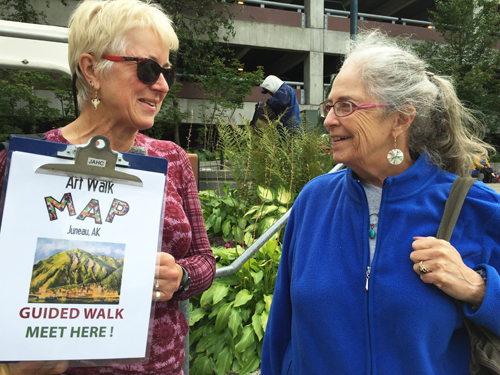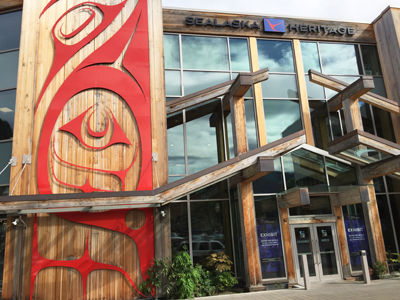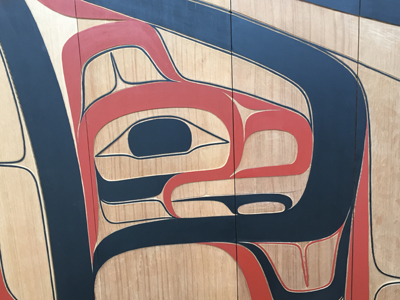Travel and Culture: Alaska- Juneau Art Walk continued
By Cornelia Seckel
arttimesjournal March 16, 2017
 Deb Rudis and Cornelia Seckel |
This was a fabulous trip and I've a lot to write about including: Juneau history, arts and peoples, ArtWalk and Artists in Juneau, Native Alaskans, Artists in Haines, Arts and Culture in Haines accompanied by some gorgeous videos and pictures. So come back to read this continuing travelogue.
See Part 1 and much of my travels can be found on my blog and selected images on instagram
I signed up for an Art Walk courtesy of the Juneau Arts and Humanities Council. Offered on Sunday thru Wednesday during “season” it is an excellent way to, in a matter of several hours, get an overview of the arts in Juneau. The tour potentially stops at about 32 galleries, public art displays and studios.
Our guide, Deb Rudis, is an active member of the Juneau Arts community and it was a pleasure to be with her. It turned out that there was just one other person on the tour, another journalist, Scott Burton, who was doing a story about the Art Walk for the local radio station KTOO a not-for-profit Juneau-based private corporation that provides a variety of telecommunications services (radio and tv) to Juneau and statewide audiences.
Here are more highlights from our walk.
 Walter Soboleff Building: Sealaska Heritage is a regional Native nonprofit 501(c)(3) corporation founded in 1980 to promote cultural diversity and cross-cultural understanding through public services and events. SHI also conducts social scientific and public policy research and advocacy that promotes Alaska Native arts, cultures, history and education statewide. |
Its mission is to perpetuate and enhance Tlingit, Haida, and Tsimshian cultures of Southeast Alaska by offering numerous programs promoting Southeast Alaskan Native culture, including language and art. Greatest Echo: Haida artist Robert Davidson, 2015, designed the 40-foot metal panels on the exterior of the building. The design represents a supernatural being called the “Greatest Echo” — a theme chosen by Davidson because Dr. Walter Soboleff, the building’s namesake, echoed the past to bring it to the present. |
 Am’ala: Wil Mangaa da Ha’lidzogat (Am’ala: He Who Holds up the Earth): (detail) Am’ala: Wil Mangaa da Ha’lidzogat (Am’ala: He Who Holds up the Earth): (detail) |
Tsimshian artist David A. Boxley, 2015, carved and painted cedar clan house front (detail) (inside the foyer). At almost 40 feet wide by 15 feet high, it is thought to be the largest, carved-and-painted Tsimshian house front in the world. The center of the house front tells the Tsimshian story Am’ala: Wil Mangaa da Ha’lidzogat (Am’ala: He Who Holds up the Earth). A tiny door in the belly of Am’ala leads into the clan house, formally named Shuká Hít (Ancestors’ House) in a ceremony. |
 The Clan House, named Shuká Hít in a ceremony, is modeled after the traditional clan houses historically seen throughout Southeast Alaska. It includes a central “fire pit” and tiers for communal activities. A traditional clan house would have included a wooden house screen with posts on one side, but—in a nod to the modern world—they have rendered them in glass. The Clan House, named Shuká Hít in a ceremony, is modeled after the traditional clan houses historically seen throughout Southeast Alaska. It includes a central “fire pit” and tiers for communal activities. A traditional clan house would have included a wooden house screen with posts on one side, but—in a nod to the modern world—they have rendered them in glass. |
In the corner of the clan house is the carved hand-print of a child. The placement of a handprint or “X” in a clan house is an ancient practice and was done during the grand opening ceremony for the building. Shuká Hít: you will see the largest glass screen in the world, made by the Tlingit glass artist Preston Singletary. Preston is internationally celebrated for his innovative creations, which use a medium not known in pre-contact times. His piece measures 17 feet wide and 12 feet high at its peak and is rendered in carved, amber-and-black glass. |
 Examples of formline design: The following is from SealaskaHeritage Introduction to Formline Design Art Kit: What is today called the formline system is the foundation of Northwest Coast Alaska Native design (2 & 3 dimensional). As the primary painted-image format of the Tlingit, Haida and Tsimshian peoples of Southeast Alaska, …formlines vary in width (hence their name) changing thickness as they flow around corners. An interconnected web of formlines is used to compose a creature image or design. They may represent stories of Raven and other creatures, historic events, clan crests, or other concepts including clouds or glaciers. … The core building-block shapes of formline design are the ovoid and U-shape. These design elements are similar in form, and the two shapes function in a cooperative way; working together to create visual balance (symmetry), and harmony in design flow and movements. …The core building-block shapes of formline design are the ovoid and U-shape. |
 These design elements are similar in form, and the two shapes function in a cooperative way; working together to create visual balance (symmetry), and harmony in design flow and movements. The Ovoids act as visual centers, or sources, from which U-shapes flow to define movements within a design or to represent wings, fins, tails, etcetera. They may represent stories of Raven and other creatures, historic events, clan crests, or other concepts including clouds or glaciers. … The core building-block shapes of formline design are the ovoid and U-shape. These design elements are similar in form, and the two shapes function in a cooperative way; working together to create visual balance (symmetry), and harmony in design flow and movements. The Ovoids act as visual centers, or sources, from which U-shapes flow to define movements within a design or to represent wings, fins, tails, etcetera. |
Lily Hope Tlingit Weaver and Teacher. We saw Lily Hope working at the Sealaska Heritage. Lily learned Ravenstail weaving from her mother Clarissa Rizal, and Kay Parker, both of Juneau. She learned Chilkat weaving from Clarissa Rizal as well, who is the last living apprentice of the late Master Chilkat Weaver, Jennie Thlanaut. Lily says of her weaving: “That’s what art means. It means our teachers don’t die. It means the spirit of all things lives on in us, in our art. We have a responsibility to honor and carry on the teachings, to keep creating, to share our version of spirit with others, so when we pass, we’ve left the world more beautiful, through our weavings and through a joyful spirit.”
 Taping the radio spot with Scott Burton at KTOO |
Scott Burton Arts, Culture and Music Producer of KTOO, KRNN, KXLL, Juneau Alaska asked me if I would be willing to join him in the studio after the Art Walk we shared with Deb Rudis and speak about my experience on the Artwalk. I enjoy radio, having done a 5-minute spot each week with Public Radio WAMC for well over 5 years. I would speak about several organizations and give information about upcoming events. That radio spot turned into my Culturally Speaking column that now has morphed into my blog CulturallySpeakingJournal.com. Follow this link to hear the interview
